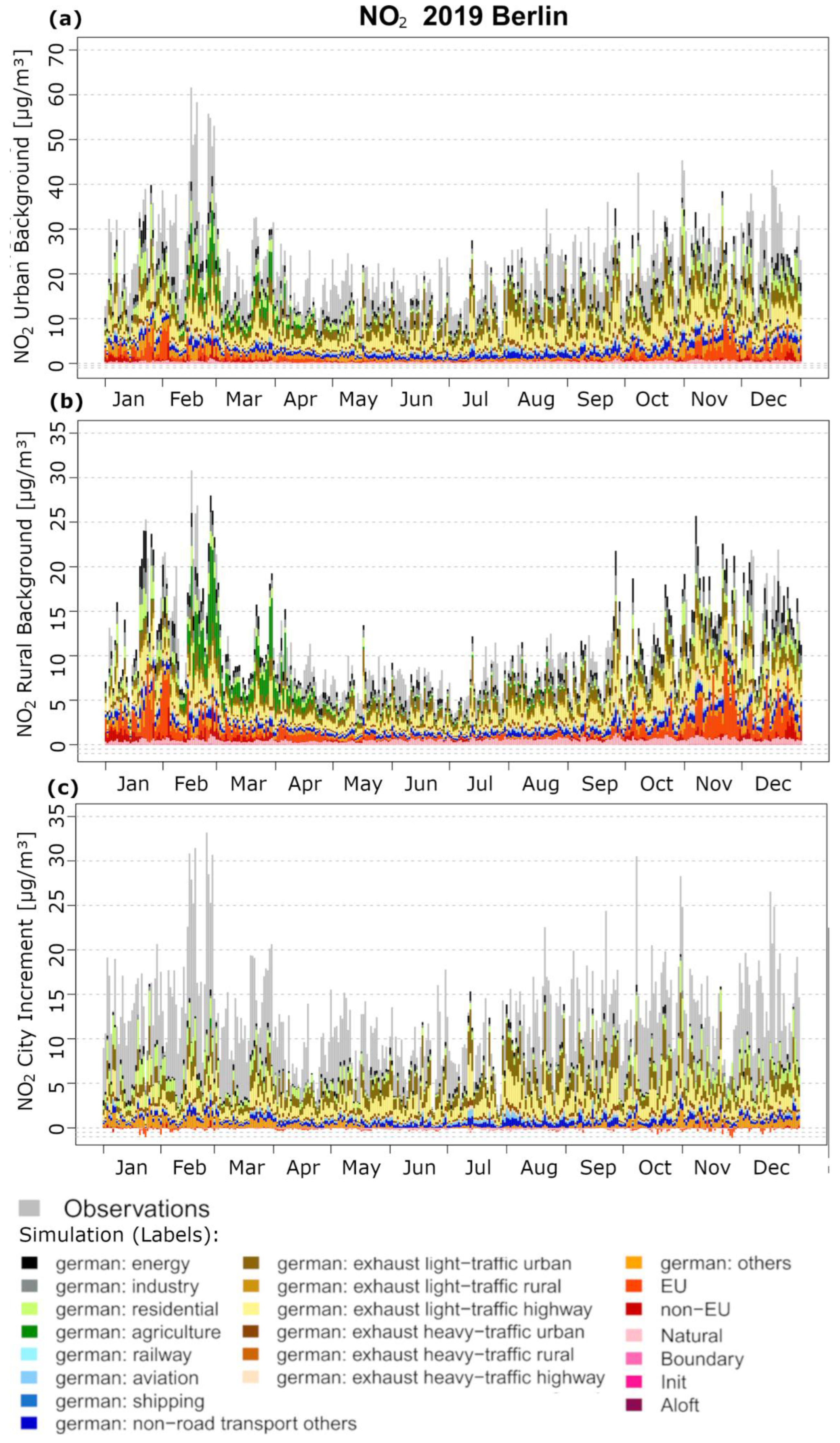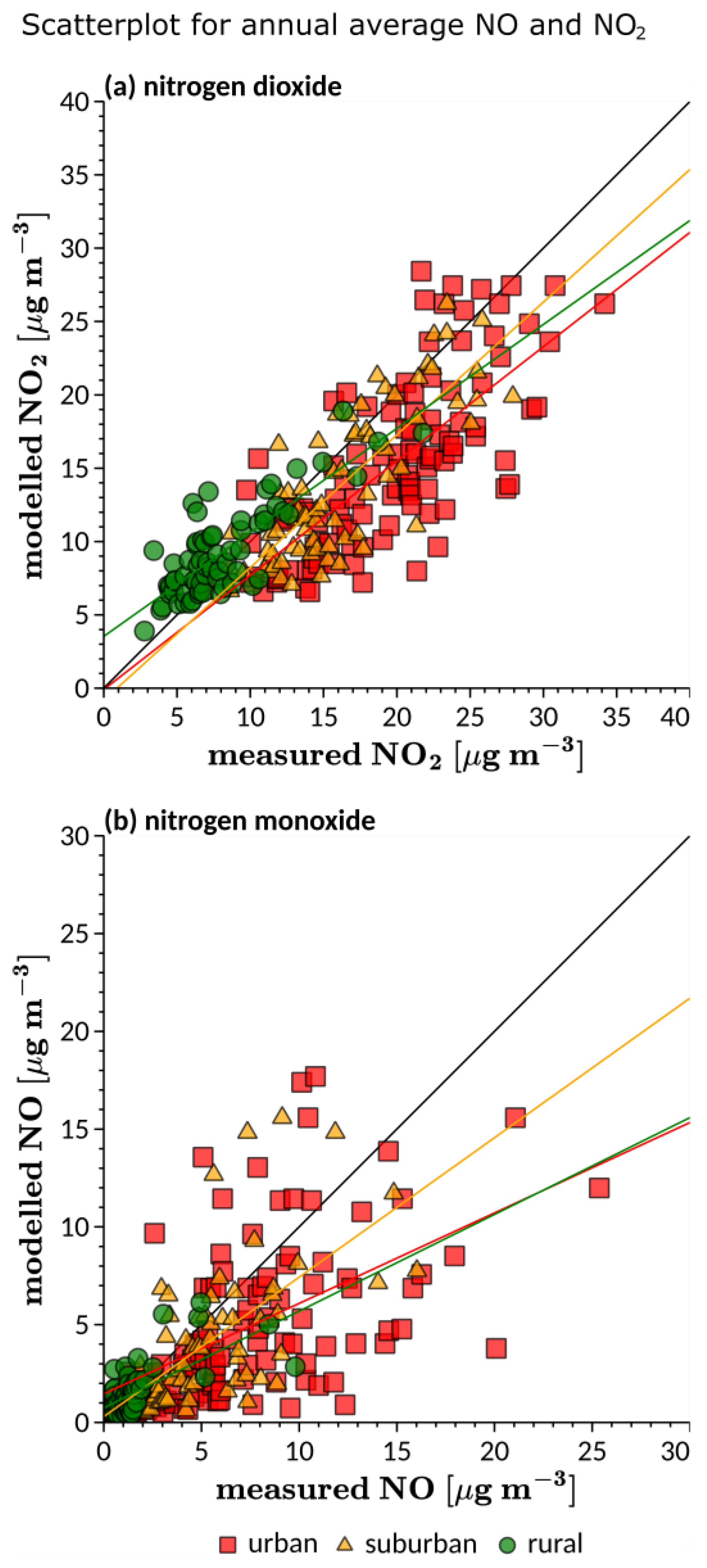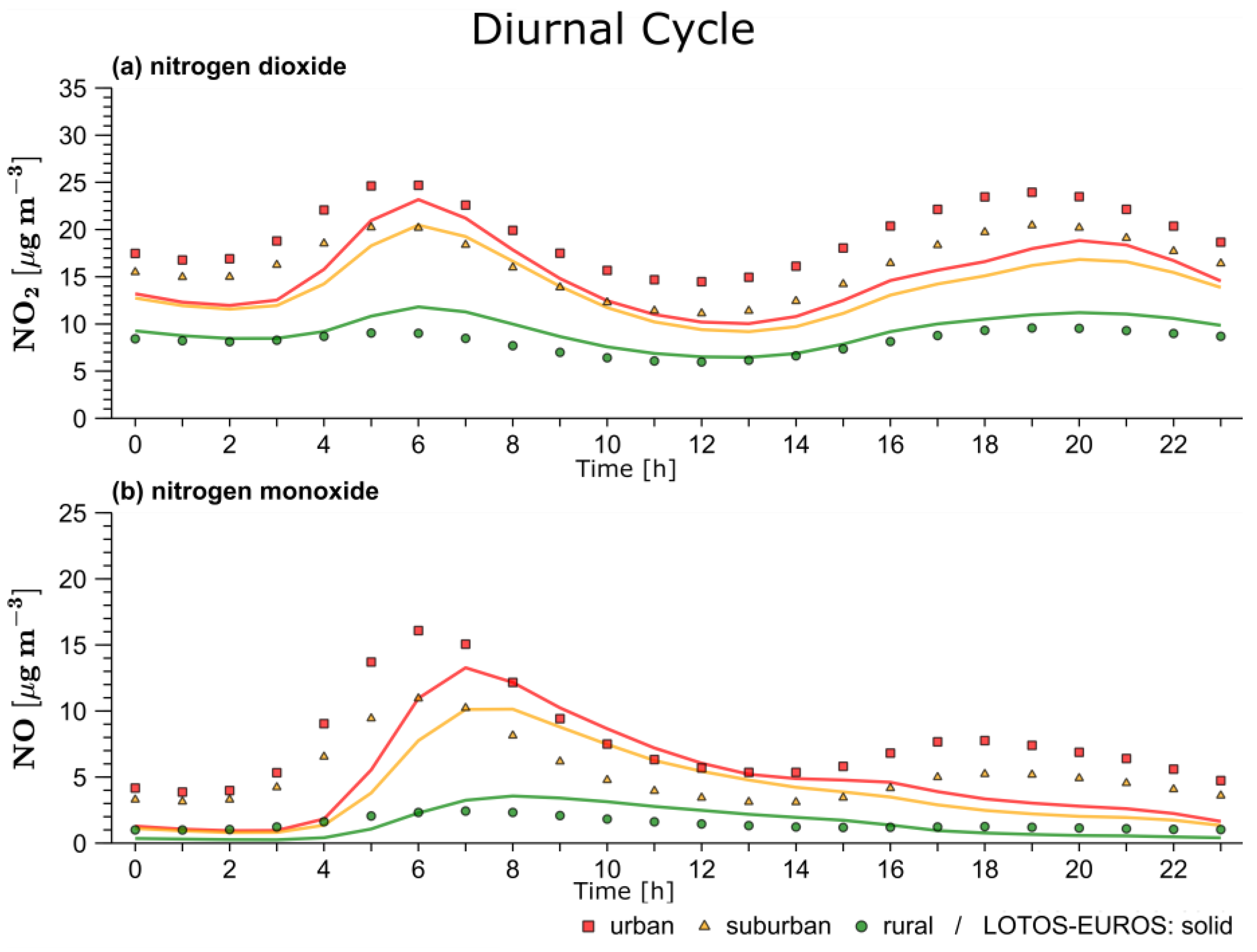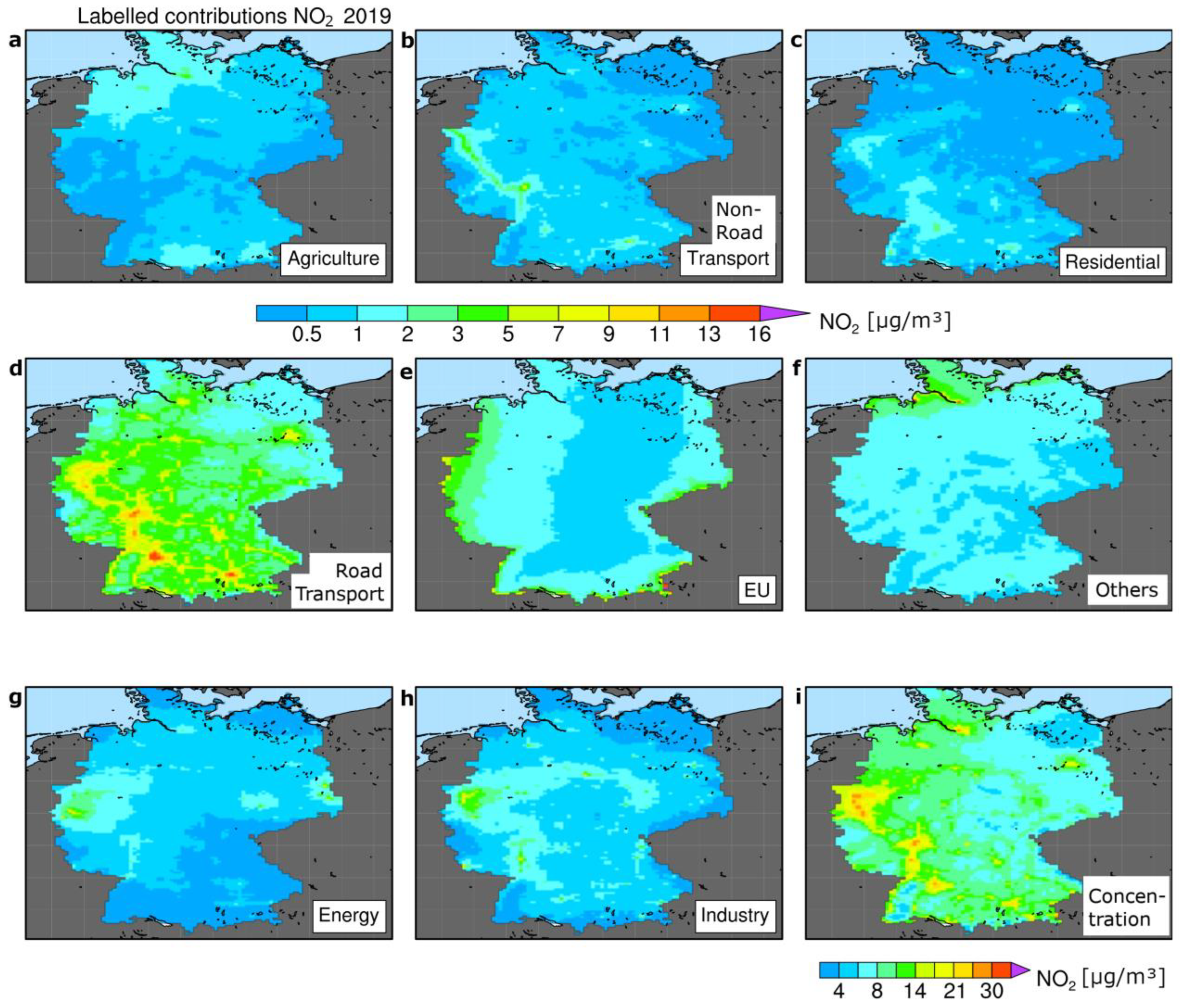Nitrogen Dioxide Source Attribution for Urban and Regional Background Locations Across Germany
Abstract
1. Introduction
2. Materials and Methods
2.1. Chemistry Transport Modelling with LOTOS-EUROS
2.2. Source Attribution of NO2
2.3. Evaluation Using Monitoring Data
3. Results and Discussion
3.1. Spatial and Temporal Distribution
3.2. Comparison Against Observations
| (a) NO2 | MB | RMSE | IOA | R | |
| Hourly | all | −2.28 | 10.64 | 0.72 | 0.58 |
| urban | −4.41 | 12.70 | 0.71 | 0.57 | |
| suburban | −2.35 | 10.93 | 0.73 | 0.58 | |
| rural | 1.19 | 7.07 | 0.72 | 0.59 | |
| Daily | all | −2.29 | 7.11 | 0.77 | 0.72 |
| urban | −4.43 | 8.71 | 0.75 | 0.71 | |
| suburban | −2.37 | 6.92 | 0.80 | 0.73 | |
| rural | 1.18 | 4.75 | 0.79 | 0.72 | |
| (b) NO | |||||
| Hourly | all | −1.57 | 13.55 | 0.46 | 0.33 |
| urban | −2.78 | 18.56 | 0.49 | 0.33 | |
| suburban | −1.26 | 14.43 | 0.47 | 0.31 | |
| rural | 0.01 | 4.76 | 0.39 | 0.35 | |
| Daily | all | −1.49 | 8.05 | 0.57 | 0.50 |
| urban | −2.62 | 11.16 | 0.62 | 0.52 | |
| suburban | −1.18 | 8.42 | 0.61 | 0.52 | |
| rural | 0.01 | 2.65 | 0.46 | 0.45 | |
3.3. Source Attribution
3.4. Case Study Berlin
4. Conclusions
Author Contributions
Funding
Institutional Review Board Statement
Informed Consent Statement
Data Availability Statement
Acknowledgments
Conflicts of Interest
References
- Newby, D.E.; Mannucci, P.M.; Tell, G.S.; Baccarelli, A.A.; Brook, R.D.; Donaldson, K.; Forastiere, F.; Franchini, M.; Franco, O.H.; Graham, I.; et al. Expert Position Paper on Air Pollution and Cardiovascular Disease. Eur. Heart J. 2015, 36, 83–93. [Google Scholar] [CrossRef] [PubMed]
- Faustini, A.; Rapp, R.; Forastiere, F. Nitrogen Dioxide and Mortality: Review and Meta-Analysis of Long-Term Studies. Eur. Respir. J. 2014, 44, 744–753. [Google Scholar] [CrossRef]
- Huang, S.; Li, H.; Wang, M.; Qian, Y.; Steenland, K.; Caudle, W.M.; Liu, Y.; Sarnat, J.; Papatheodorou, S.; Shi, L. Long-Term Exposure to Nitrogen Dioxide and Mortality: A Systematic Review and Meta-Analysis. Sci. Total Environ. 2021, 776, 145968. [Google Scholar] [CrossRef] [PubMed]
- Raaschou-Nielsen, O.; Andersen, Z.J.; Jensen, S.S.; Ketzel, M.; Sørensen, M.; Hansen, J.; Loft, S.; Tjønneland, A.; Overvad, K. Traffic Air Pollution and Mortality from Cardiovascular Disease and All Causes: A Danish Cohort Study. Environ. Health 2012, 11, 60. [Google Scholar] [CrossRef]
- European Environment Agency. Air Quality in Europe 2022; European Environment Agency: Copenhagen, Denmark, 2023. [Google Scholar]
- Huangfu, P.; Atkinson, R. Long-Term Exposure to NO2 and O3 and All-Cause and Respiratory Mortality: A Systematic Review and Meta-Analysis. Environ. Int. 2020, 144, 105998. [Google Scholar] [CrossRef]
- van Pinxteren, D.; Engelhardt, V.; Mothes, F.; Poulain, L.; Fomba, K.W.; Spindler, G.; Cuesta-Mosquera, A.; Tuch, T.; Müller, T.; Wiedensohler, A.; et al. Residential Wood Combustion in Germany: A Twin-Site Study of Local Village Contributions to Particulate Pollutants and Their Potential Health Effects. ACS Environ. Au 2024, 4, 12–30. [Google Scholar] [CrossRef]
- WHO Regional Office for Europe. Economic Cost of the Health Impact of Air Pollution in Europe Clean Air, Health and Wealth; WHO Regional Office for Europe: Copenhagen, Denmark, 2015. [Google Scholar]
- COMEAP. Statement on the Evidence for the Effects of Nitrogen Dioxide on Health. In Committe on the Medical Effects or Air Pollutants; UK Government: London, UK, 2015. [Google Scholar]
- Fischer, P.H.; Marra, M.; Ameling, C.B.; Hoek, G.; Beelen, R.; De Hoogh, K.; Breugelmans, O.; Kruize, H.; Janssen, N.A.H.; Houthuijs, D. Air Pollution and Mortality in Seven Million Adults: The Dutch Environmental Longitudinal Study (DUELS). Environ. Health Perspect. 2015, 123, 697–704. [Google Scholar] [CrossRef] [PubMed]
- Anenberg, S.C.; Mohegh, A.; Goldberg, D.L.; Kerr, G.H.; Brauer ScD, M.; Burkart, K.; Wozniak, S.B.; Hystad, P.; Larkin, A.; Anenberg, S.C.; et al. Long-Term Trends in Urban NO2 Concentrations and Associated Paediatric Asthma Incidence: Estimates from Global Datasets. Lancet Planet. Health 2022, 6, e49–e58. [Google Scholar] [CrossRef]
- Erickson, L.E.; Newmark, G.L.; Higgins, M.J.; Wang, Z. Nitrogen Oxides and Ozone in Urban Air: A Review of 50 plus Years of Progress. Environ. Prog. Sustain. Energy 2020, 39, e13484. [Google Scholar] [CrossRef]
- European Environment Agency. Air Quality in Europe: 2020 Report; Publications Office of the European Union: Copenhagen, Denmark, 2020; ISBN 9789294802927. [Google Scholar]
- Umweltbundesamt Luftqualität. 2020 Vorläufige Auswertung; Umweltbundesamt Luftqualität: Dessau-Roßlau, Germany, 2021. [Google Scholar]
- European Commission. I Directive 2008/50/EC of the European Parliament and of the Council of 21 May 2008 on Ambient Air Quality and Cleaner Air for Europe; European Commission: Brussels, Belgium, 2008. [Google Scholar]
- Umweltbundesamt Luftqualität. 2023 (Vorläufige Auswertung); Umweltbundesamt Luftqualität: Dessau-Roßlau, Germany, 2024. [Google Scholar]
- World Health Organization. WHO Global Air Quality Guidelines. Particulate Matter (PM2.5 and PM10), Ozone, Nitrogen Dioxide, Sulfur Dioxide and Carbon Monoxide; WHO: Geneva, Switzerland, 2021. [Google Scholar]
- European Commission. Proposal for a Directive of the European Parliament and of the Council on Ambient Air Quality and Cleaner Air for Europe (Recast); European Commission: Brussels, Belgium, 2022. [Google Scholar]
- Nuvolone, D.; Petri, D.; Voller, F. The Effects of Ozone on Human Health. Environ. Sci. Pollut. Res. 2018, 25, 8074–8088. [Google Scholar] [CrossRef]
- Bromberg, P.A. Mechanisms of the Acute Effects of Inhaled Ozone in Humans. Biochim. Biophys. Acta (BBA)-Gen. Subj. 2016, 1860, 2771–2781. [Google Scholar] [CrossRef] [PubMed]
- Holm, S.M.; Balmes, J.R. Systematic Review of Ozone Effects on Human Lung Function, 2013 Through 2020. Chest 2022, 161, 190–201. [Google Scholar] [CrossRef]
- Sandermann, H. Ozone and Plant Health. Annu. Rev. Phytopathol. 1996, 34, 347–366. [Google Scholar] [CrossRef]
- Agathokleous, E.; Feng, Z.; Oksanen, E.; Sicard, P.; Wang, Q.; Saitanis, C.J.; Araminiene, V.; Blande, J.D.; Hayes, F.; Calatayud, V.; et al. Ozone Affects Plant, Insect, and Soil Microbial Communities: A Threat to Terrestrial Ecosystems and Biodiversity. Sci. Adv. 2020, 6, eabc1176. [Google Scholar] [CrossRef] [PubMed]
- van Pinxteren, D.; Mothes, F.; Spindler, G.; Fomba, K.W.; Herrmann, H. Trans-Boundary PM10: Quantifying Impact and Sources during Winter 2016/17 in Eastern Germany. Atmos. Environ. 2019, 200, 119–130. [Google Scholar] [CrossRef]
- Garcia, A.; Santa-Helena, E.; De Falco, A.; de Paula Ribeiro, J.; Gioda, A.; Gioda, C.R. Toxicological Effects of Fine Particulate Matter (PM2.5): Health Risks and Associated Systemic Injuries—Systematic Review. Water Air Soil Pollut. 2023, 234, 346. [Google Scholar] [CrossRef] [PubMed]
- Fowler, D.; Coyle, M.; Skiba, U.; Sutton, M.A.; Cape, J.N.; Reis, S.; Sheppard, L.J.; Jenkins, A.; Grizzetti, B.; Galloway, J.N.; et al. The Global Nitrogen Cycle in the Twenty-First Century. Philos. Trans. R. Soc. B Biol. Sci. 2013, 368, 20130164. [Google Scholar] [CrossRef]
- Jonson, J.E.; Fagerli, H.; Scheuschner, T.; Tsyro, S. Modelling Changes in Secondary Inorganic Aerosol Formation and Nitrogen Deposition in Europe from 2005 to 2030. Atmos. Chem. Phys. 2022, 22, 1311–1331. [Google Scholar] [CrossRef]
- Butler, T.; Lupascu, A.; Coates, J.; Zhu, S. TOAST 1.0: Tropospheric Ozone Attribution of Sources with Tagging for CESM 1.2.2. Geosci. Model Dev. 2018, 11, 2825–2840. [Google Scholar] [CrossRef]
- Bartík, L.; Huszár, P.; Karlický, J.; Vlček, O.; Eben, K. Modeling the Drivers of Fine PM Pollution over Central Europe: Impacts and Contributions of Emissions from Different Sources. Atmos. Chem. Phys. 2024, 24, 4347–4387. [Google Scholar] [CrossRef]
- Pültz, J.; Banzhaf, S.; Thürkow, M.; Kranenburg, R.; Schaap, M. Source Attribution of Particulate Matter in Berlin. Atmos. Environ. 2023, 292, 119416. [Google Scholar] [CrossRef]
- Carruthers, D.J.; Edmunds, H.A.; Lester, A.E.; McHugh, C.A.; Singles, R.J. Use and Validation of ADMS-Urban in Contrasting Urban and Industrial Locations. Int. J. Environ. Pollut. 2000, 14, 364–374. [Google Scholar] [CrossRef]
- Schiavon, M.; Redivo, M.; Antonacci, G.; Rada, E.C.; Ragazzi, M.; Zardi, D.; Giovannini, L. Assessing the Air Quality Impact of Nitrogen Oxides and Benzene from Road Traffic and Domestic Heating and the Associated Cancer Risk in an Urban Area of Verona (Italy). Atmos. Environ. 2015, 120, 234–243. [Google Scholar] [CrossRef]
- Tilloy, A.; Mallet, V.; Poulet, D.; Pesin, C.; Brocheton, F. BLUE-Based NO2 Data Assimilation at Urban Scale. J. Geophys. Res. Atmos. 2013, 118, 2031–2040. [Google Scholar] [CrossRef]
- Wagstrom, K.M.; Pandis, S.N.; Yarwood, G.; Wilson, G.M.; Morris, R.E. Development and Application of a Computationally Efficient Particulate Matter Apportionment Algorithm in a Three-Dimensional Chemical Transport Model. Atmos. Environ. 2008, 42, 5650–5659. [Google Scholar] [CrossRef]
- Belis, C.A.; Pirovano, G.; Villani, M.G.; Calori, G.; Pepe, N.; Putaud, J.P. Comparison of Source Apportionment Approaches and Analysis of Non-Linearity in a Real Case Model Application. Geosci. Model Dev. 2021, 14, 4731–4750. [Google Scholar] [CrossRef]
- Clappier, A.; Belis, C.A.; Pernigotti, D.; Thunis, P. Source Apportionment and Sensitivity Analysis: Two Methodologies with Two Different Purposes. Geosci. Model Dev. 2017, 10, 4245–4256. [Google Scholar] [CrossRef]
- Thürkow, M.; Banzhaf, S.; Butler, T.; Pültz, J.; Schaap, M. Source Attribution of Nitrogen Oxides across Germany: Comparing the Labelling Approach and Brute Force Technique with LOTOS-EUROS. Atmos. Environ. 2023, 292, 119412. [Google Scholar] [CrossRef]
- Marécal, V.; Peuch, V.H.; Andersson, C.; Andersson, S.; Arteta, J.; Beekmann, M.; Benedictow, A.; Bergström, R.; Bessagnet, B.; Cansado, A.; et al. A Regional Air Quality Forecasting System over Europe: The MACC-II Daily Ensemble Production. Geosci. Model Dev. 2015, 8, 2777–2813. [Google Scholar] [CrossRef]
- Pommier, M.; Fagerli, H.; Schulz, M.; Valdebenito, A.; Kranenburg, R.; Schaap, M. Prediction of Source Contributions to Urban Background PM10 Concentrations in European Cities: A Case Study for an Episode in December 2016 Using EMEP/MSC-W Rv4.15 and LOTOS-EUROS v2.0—Part 1: The Country Contributions. Geosci. Model Dev. 2020, 13, 1787–1807. [Google Scholar] [CrossRef]
- Bessagnet, B.; Pirovano, G.; Mircea, M.; Cuvelier, C.; Aulinger, A.; Calori, G.; Ciarelli, G.; Manders, A.; Stern, R.; Tsyro, S.; et al. Presentation of the EURODELTA III Intercomparison Exercise-Evaluation of the Chemistry Transport Models’ Performance on Criteria Pollutants and Joint Analysis with Meteorology. Atmos. Chem. Phys. 2016, 16, 12667–12701. [Google Scholar] [CrossRef]
- Thürkow, M.; Schaap, M.; Kranenburg, R.; Pfäfflin, F.; Neunhäuserer, L.; Wolke, R.; Heinold, B.; Stoll, J.; Lupaşcu, A.; Nordmann, S.; et al. Dynamic Evaluation of Modeled Ozone Concentrations in Germany with Four Chemistry Transport Models. Sci. Total Environ. 2024, 906, 167665. [Google Scholar] [CrossRef] [PubMed]
- Manders, A.M.M.; Builtjes, P.J.H.; Curier, L.; Denier van der Gon, H.A.; Hendriks, C.; Jonkers, S.; Kranenburg, R.; Kuenen, J.J.P.; Segers, A.J.; Timmermans, R.M.A.; et al. Curriculum Vitae of the LOTOS-EUROS (v2.0) Chemistry Transport Model. Geosci. Model Dev. 2017, 10, 4145–4173. [Google Scholar] [CrossRef]
- Reinert, D.; Prill, F.; Frank, H.; Zängl, G. ICON Database Reference Manual; Deutscher Wetterdienst: Offenbach, Germany, 2015. [Google Scholar]
- Inness, A.; Ades, M.; Agustí-Panareda, A.; Barr, J.; Benedictow, A.; Blechschmidt, A.M.; Jose Dominguez, J.; Engelen, R.; Eskes, H.; Flemming, J.; et al. The CAMS Reanalysis of Atmospheric Composition. Atmos. Chem. Phys. 2019, 19, 3515–3556. [Google Scholar] [CrossRef]
- Kuenen, J.; Dellaert, S.; Visschedijk, A.; Jalkanen, J.P.; Super, I.; Denier Van Der Gon, H. CAMS-REG-v4: A State-of-the-Art High-Resolution European Emission Inventory for Air Quality Modelling. Earth Syst. Sci. Data 2022, 14, 491–515. [Google Scholar] [CrossRef]
- Schneider, C.; Pelzer, M.; Toenges-Schuller, N.; Nacken, M.; Niederau, A. ArcGIS Basierte Lösung Zur Detaillierten, Deutsch-Landweiten Verteilung (Gridding) Nationaler Emissionsjahreswerte Auf Basis Des Inventars Zur Emissionsbericht-Erstattung Langfassung. Dessau. Roßlau Retrieved 2016, 27, 2019. [Google Scholar]
- Kaiser, J.W.; Heil, A.; Andreae, M.O.; Benedetti, A.; Chubarova, N.; Jones, L.; Morcrette, J.J.; Razinger, M.; Schultz, M.G.; Suttie, M.; et al. Biomass Burning Emissions Estimated with a Global Fire Assimilation System Based on Observed Fire Radiative Power. Biogeosciences 2012, 9, 527–554. [Google Scholar] [CrossRef]
- Denier Van Der Gon, H.A.C.; Bergström, R.; Fountoukis, C.; Johansson, C.; Pandis, S.N.; Simpson, D.; Visschedijk, A.J.H. Particulate Emissions from Residential Wood Combustion in Europe—Revised Estimates and an Evaluation. Atmos. Chem. Phys. 2015, 15, 6503–6519. [Google Scholar] [CrossRef]
- Kuik, F.; Kerschbaumer, A.; Lauer, A.; Lupascu, A.; Von Schneidemesser, E.; Butler, T.M. Top-down Quantification of NOx Emissions from Traffic in an Urban Area Using a High-Resolution Regional Atmospheric Chemistry Model. Atmos. Chem. Phys. 2018, 18, 8203–8225. [Google Scholar] [CrossRef]
- Karl, M.; Acksen, S.; Chaudhary, R.; Ramacher, M.O.P. Forecasting System for Urban Air Quality with Automatic Correction and Web Service for Public Dissemination. Int. J. Digit. Earth 2024, 17, 1–22. [Google Scholar] [CrossRef]
- Ramacher, M.O.P.; Badeke, R.; Fink, L.; Quante, M.; Karl, M.; Oppo, S.; Lenartz, F.; Dury, M.; Matthias, V. Assessing the Effects of Significant Activity Changes on Urban-Scale Air Quality across Three European Cities. Atmos. Environ. X 2024, 22, 100264. [Google Scholar] [CrossRef]
- Janssen, S.; Thunis, P. FAIRMODE Guidance Document on Modelling Quality Objectives and Benchmarking (version 3.3); EUR 31068 EN; Publications Office of the European Union: Luxembourg, 2022; ISBN 978-92-76-52425-0. [Google Scholar]
- Grange, S.K.; Farren, N.J.; Vaughan, A.R.; Rose, R.A.; Carslaw, D.C. Strong Temperature Dependence for Light-Duty Diesel Vehicle NOx Emissions. Environ. Sci. Technol. 2019, 53, 6587–6596. [Google Scholar] [CrossRef] [PubMed]
- Kuik, F.; Lauer, A.; Churkina, G.; Denier Van Der Gon, H.A.C.; Fenner, D.; Mar, K.A.; Butler, T.M. Air Quality Modelling in the Berlin-Brandenburg Region Using WRF-Chem v3.7.1: Sensitivity to Resolution of Model Grid and Input Data. Geosci. Model Dev. 2016, 9, 4339–4363. [Google Scholar] [CrossRef]
- Tokaya, J.P.; Kranenburg, R.; Timmermans, R.M.A.; Coenen, P.W.H.G.; Kelly, B.; Hullegie, J.S.; Megaritis, T.; Valastro, G. The Impact of Shipping on the Air Quality in European Port Cities with a Detailed Analysis for Rotterdam. Atmos. Environ. X 2024, 23, 100278. [Google Scholar] [CrossRef]
- Harkey, M.; Holloway, T.; Oberman, J.; Scotty, E. An Evaluation of CMAQ NO2 using Observed Chemistry-Meteorology Correlations. J. Geophys. Res. 2015, 120, 11775–11797. [Google Scholar] [CrossRef]
- Baklanov, A.; Schlünzen, K.; Suppan, P.; Baldasano, J.; Brunner, D.; Aksoyoglu, S.; Carmichael, G.; Douros, J.; Flemming, J.; Forkel, R.; et al. Online Coupled Regional Meteorology Chemistry Models in Europe: Current Status and Prospects. Atmos. Chem. Phys. 2014, 14, 317–398. [Google Scholar] [CrossRef]
- Thürkow, M.; Kirchner, I.; Kranenburg, R.; Timmermans, R.M.A.; Schaap, M. A Multi-Meteorological Comparison for Episodes of PM10 Concentrations in the Berlin Agglomeration Area in Germany with the LOTOS-EUROS CTM. Atmos. Environ. 2021, 244, 117946. [Google Scholar] [CrossRef]
- Wærsted, E.G.; Sundvor, I.; Denby, B.R.; Mu, Q. Quantification of Temperature Dependence of NOx Emissions from Road Traffic in Norway Using Air Quality Modelling and Monitoring Data. Atmos. Environ. X 2022, 13, 100160. [Google Scholar] [CrossRef]
- Jiang, Y.; Song, G.; Wu, Y.; Lu, H.; Zhai, Z.; Yu, L. Impacts of Cold Starts and Hybrid Electric Vehicles on On-Road Vehicle Emissions. Transp. Res. D Transp. Environ. 2024, 126, 104011. [Google Scholar] [CrossRef]
- Hall, D.L.; Anderson, D.C.; Martin, C.R.; Ren, X.; Salawitch, R.J.; He, H.; Canty, T.P.; Hains, J.C.; Dickerson, R.R. Using Near-Road Observations of CO, NOy, and CO2 to Investigate Emissions from Vehicles: Evidence for an Impact of Ambient Temperature and Specific Humidity. Atmos. Environ. 2020, 232, 117558. [Google Scholar] [CrossRef]
- Roxon, J.; Ulm, F.J.; Pellenq, R.J.M. Urban Heat Island Impact on State Residential Energy Cost and CO2 Emissions in the United States. Urban Clim. 2020, 31, 100546. [Google Scholar] [CrossRef]
- Loris Bennett, B.M.B.P. Curta: A General-Purpose High-Performance Computer at ZEDAT; Freie Universität: Berlin, Germany, 2020. [Google Scholar] [CrossRef]









| State Capital | Selected Sites | ||||
|---|---|---|---|---|---|
| Name (State) | Inhabitants (2022) (State Population) | Area [km2] | Centre of Area [lat/lon] | Urban Background (Radius for Selection [km]) | Rural Background |
| Stuttgart (Baden-Württemberg) | 0.63 Mio (11.1 Mio) | 207 | 48.775092 9.172033 | DEBW013 (R = 8.1) | DEBW004, DEBW087 |
| Munich (Bavaria) | 1.51 Mio (13.1 Mio) | 310 | 48.139722 11.574444 | DEBY039 (R = 9.9) | DEBY013, DEBY049 DEBY109, DEBY196 |
| Berlin (Berlin) | 3.75 Mio (3.7 Mio) | 891 | 52.502889 13.404194 | DEBE010, DEBE018, DEBE034, DEBE066, DEBE068 (R = 16.8) | DEBB053, DEBB065, DEBB066, DEBE027, DEBE032, DEBE056, DEBE062 |
| Potsdam (Brandenburg) | 0.18 Mio (2.5 Mio) | 188 | 52.39886 13.06566 | DEBB021 (R = 7.7) | DEBB053, DEBB065, DEBE027, DEBE032, DEBE056, DEBE062 |
| Bremen (Free Hanseatic Bremen) | 0.56 Mio (0.6 Mio) | 318 | 53.07516 8.80777 | DEHB001, DEHB002, DEHB012 (R = 10.1) | DENI031, DENI059, DENI063 |
| Hamburg (Hamburg) | 1.89 Mio (1.9 Mio) | 755 | 53.550556 9.993333 | DEHH008, DEHH033, DEHH059, DEHH079, DEHH081 (R = 15.5) | DENI063, DESH008 |
| Wiesbaden (Hesse) | 0.28 Mio (6.3 Mio) | 203 | 50.0782 8.2398 | DEHE022, DERP007 (R = 8.0) | DEBY004, DEHE026, DEHE028, DEHE042, DEHE043, DEHE052, DERP014, DERP016, DERP028 |
| Rostock (Mecklenburg Western Pomerania) | 0.20 Mio. (1.6 Mio) | 181 (130) | 54.0924 12.0991 | DEMV021 (R = 9) | DEMV004, DEMV024, DEUB028 |
| Hanover (Lower Saxony) | 0.54 Mio (8.1 Mio) | 204 | 52.3759 9.7320 | DENI054 (R = 8.1) | DENI077, DEUB005 |
| Düsseldorf (North Rhine–Westphalia) | 0.62 Mio (17.9 Mio) | 217 | 51.2277 6.7735 | DENW071, DENW381 (R = 8.3) | DENW064, DENW066, DENW081 |
| Mainz (Rhineland–Palatinate) | 0.21 Mio (4.1 Mio) | 97 | 49.9929 8.2473 | DERP007, DERP009 (R = 8.6) | DEBY004, DEHE028, DEHE042, DEHE043, DEHE052, DERP014, DERP028 |
| Saarbrucken (Saarland) | 0.18 Mio (0.9 Mio) | 167 | 49.2402 6.9969 | DESL010, DESL011, DESL012 (R = 7.3) | DERP013, DERP014, DERP017, DESL019 |
| Dresden (Saxony) | 0.56 Mio (4.1 Mio) | 328 | 51.0504 13.7373 | DESN092 (R = 10.2) | DESN051, DESN052, DESN074, DESN076, DESN079 |
| Magdeburg (Saxony–Anhalt) | 0.23 Mio (2.2 Mio) | 201 | 52.1205 11.6276 | DEST077 (R = 8.0) | DEBB065, DEST089, DEST098, DEST104 |
| Kiel (Schleswig Holstein) | 0.24 Mio (2.9 Mio) | 118 | 54.3224 10.1331 | DESH057 (R = 6.1) | DESH008, DESH056 |
| Erfurt (Thuringia) | 0.21 Mio (2.1 Mio) | 269 | 50.9848 11.0299 | DETH020 (R = 9.3) | DEST098, DETH026, DETH027, DETH042, DETH061 |
Disclaimer/Publisher’s Note: The statements, opinions and data contained in all publications are solely those of the individual author(s) and contributor(s) and not of MDPI and/or the editor(s). MDPI and/or the editor(s) disclaim responsibility for any injury to people or property resulting from any ideas, methods, instructions or products referred to in the content. |
© 2025 by the authors. Licensee MDPI, Basel, Switzerland. This article is an open access article distributed under the terms and conditions of the Creative Commons Attribution (CC BY) license (https://creativecommons.org/licenses/by/4.0/).
Share and Cite
Pültz, J.; Thürkow, M.; Banzhaf, S.; Schaap, M. Nitrogen Dioxide Source Attribution for Urban and Regional Background Locations Across Germany. Atmosphere 2025, 16, 312. https://doi.org/10.3390/atmos16030312
Pültz J, Thürkow M, Banzhaf S, Schaap M. Nitrogen Dioxide Source Attribution for Urban and Regional Background Locations Across Germany. Atmosphere. 2025; 16(3):312. https://doi.org/10.3390/atmos16030312
Chicago/Turabian StylePültz, Joscha, Markus Thürkow, Sabine Banzhaf, and Martijn Schaap. 2025. "Nitrogen Dioxide Source Attribution for Urban and Regional Background Locations Across Germany" Atmosphere 16, no. 3: 312. https://doi.org/10.3390/atmos16030312
APA StylePültz, J., Thürkow, M., Banzhaf, S., & Schaap, M. (2025). Nitrogen Dioxide Source Attribution for Urban and Regional Background Locations Across Germany. Atmosphere, 16(3), 312. https://doi.org/10.3390/atmos16030312






